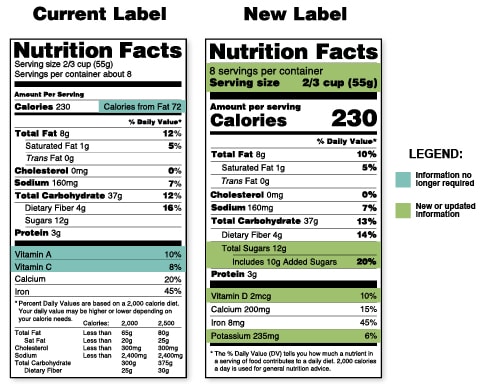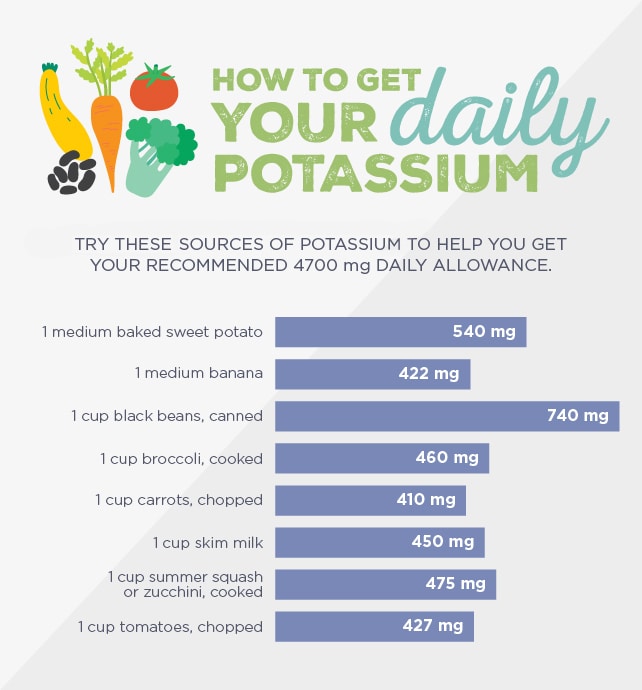Updated December 28, 2021
You may have noticed the changes to Nutrition Facts on food labels. In 2016, the Food and Drug Administration (FDA) announced an updated Nutrition Facts label for packaged foods that reflects new scientific information, including the link between diet and chronic diseases such as obesity and heart disease. The FDA required major food manufacturers to update their labels with the new information and standards by January 1, 2020.1

Food labels explained.
The updated Nutrition Facts make it easier for you to choose foods that are right for you and your family—and to take steps to improve or maintain your health. Publix is here to help you navigate the changes so you know what to look for on the new labels.

Sizing up servings.
What’s new and why:
- Servings per Container and Serving Size now appear in larger, bolder type.
- Serving sizes are updated to better reflect what people actually eat and drink.2
- Smaller packages previously labeled as containing 1–2 servings are now considered single servings, with Nutrition Facts representing the entire container. For example, a 20-ounce drink is treated as a single serving, and ice cream servings changed from 1/2 cup to 2/3 cup.
- Packages containing 2–3 servings now show nutrition facts per serving and per container.
Nutrition tips:
- Compare apples to apples. When measuring calories and nutrients in different foods, check the serving sizes to make an accurate comparison.
- Watch your portions. How do they compare to the serving size on the package? If you eat two times the serving size, then you need to double the calories, total fat, saturated fat, etc. listed on the package.
Considering fat: quality vs quantity.
What’s new:
- Based on research showing that the type of fat is more important than the amount, the Calories from Fat line has been removed.
- Total Fat and the subcategories Saturated Fat and Trans Fat are still required.
Get more details on types of fat and managing your fat intake here.
New addition: Added Sugars.
What’s new and why:
- While the old label lists all sugars in a product, the new label lists both Total Sugars and Added Sugars (in grams), which are sugars that are not naturally occurring in a food or beverage. Scientific data shows that it is difficult to meet nutrient needs while staying within calorie limits if you consume too many added sugars. This new category helps consumers track their intake of
added sugars. - There is also a new percent daily value (% DV) for added sugars (based on a daily value of 50 grams). This reflects the 2020–2025 Dietary Guidelines for Americans' recommendation of no more than 10% of total daily calories from added sugars.
Nutrition tips:
- When shopping at Publix, use our green Better Choice shelf tags to help you select products lower in added sugars.
- As you read food labels, look for products that contain 5% or less daily value (DV) for added sugars.
- Learn more about avoiding added sugars in beverages, meals, and snacks.
Ins and outs of nutrients.
What’s new and why:
- Updates to the list of nutrients on the label include:
- Vitamins A and C are no longer required, since deficiencies in these vitamins are rare today.
- Potassium and vitamin D are required because many Americans do not get enough of these nutrients, which may lead to an increased risk of chronic disease.3
- Calcium and iron are still required.
- Daily values for nutrients have also been updated based on new scientific evidence. The daily values are reference amounts of nutrients to consume (or not to exceed) and are used to calculate the percent daily value.
Let’s explore potassium and vitamin D, why they’re essential nutrients, and how to get enough of them.
Push for potassium.
What does potassium do? It helps muscles contract, regulates fluids and mineral balance, and assists in maintaining normal blood pressure.4
How much potassium do you need? The percent daily value has increased from 3500 mg to 4700 mg per day.
Where can you find potassium? It’s found in many fruits and vegetables, such as beans, sweet potatoes, potatoes, tomatoes, raisins and dried apricots, cantaloupe, and bananas. 5

Discover vitamin D.
What does vitamin D do? It helps maintain strong bones by aiding in calcium absorption from foods and supplements.6
How much vitamin D do you need? The percent daily value for vitamin D has doubled from 400 IU to 800 IU (international units), or 20 mcg. It is also now measured in micrograms (1 mcg = 40 IU).
Where do you find vitamin D? Very few foods contain vitamin D naturally. Fortified foods such as milk provide most of the vitamin D in American diets. Salmon, tuna, and other fatty fish are among the best sources. Beef liver, cheese, and egg yolks provide small amounts.
Try these tips for increasing your vitamin D intake:
- Get milk! Most of the US milk supply is fortified with vitamin D (3 mcg/120 IU per cup). Many plant-based milk beverages also contain it. Check out Publix soymilk (30% DV) and almondmilk (10% DV). Keep in mind that foods made from milk, such as cheese and ice cream, are usually not fortified.
- Start the day with vitamin D. Vitamin D is added to many breakfast cereals and to some brands of orange juice, margarine, and yogurt.6
- Savor the salmon. Salmon is available year-round, and whether fresh or frozen, it’s a great way to get more vitamin D in your diet. Publix offers a variety of succulent salmon recipes to try.
- Be sure to visit our How to Read a Label article for more details on the Nutrition Facts label updates.
Sources
1 U.S. Department of Health & Human Services (HHS). Changes to the Nutrition Facts Label. U.S. Food & Drug Administration (FDA). February 10, 2020.
2 U.S. Department of Health & Human Services (HHS). Serving Sizes Get a Reality Check. U.S. Food & Drug Administration (FDA). Accessed October 29, 2018.
3 Centers for Disease Control and Prevention (CDC). National Health and Nutrition Examination Survey. National Center for Health Statistics (NCHS). September 20, 2021.
4 Klemm, Sara, RDN, CD, LDN. What Is Potassium? EatRight.org. March 2, 2021.
5 FoodData Central. Potassium (mg) per 100 Unit Serving. U.S. Department of Agriculture (USDA): Agricultural Research Service. Accessed November 3, 2021.
6 U.S. Department of Health & Human Services (HHS). Vitamin D Fact Sheet for Consumers. National Institutes of Health (NIH): Office of Dietary Supplements. March 22, 2021.

 You are about to leave publix.com and enter the Instacart site that they operate and control. Publix’s delivery and curbside pickup item prices are higher than item prices in physical store locations. Prices are based on data collected in store and are subject to delays and errors. Fees, tips & taxes may apply. Subject to terms & availability. Publix Liquors orders cannot be combined with grocery delivery. Drink Responsibly. Be 21. For prescription delivery, log in to your pharmacy account by using the Publix Pharmacy app or visiting
You are about to leave publix.com and enter the Instacart site that they operate and control. Publix’s delivery and curbside pickup item prices are higher than item prices in physical store locations. Prices are based on data collected in store and are subject to delays and errors. Fees, tips & taxes may apply. Subject to terms & availability. Publix Liquors orders cannot be combined with grocery delivery. Drink Responsibly. Be 21. For prescription delivery, log in to your pharmacy account by using the Publix Pharmacy app or visiting 
